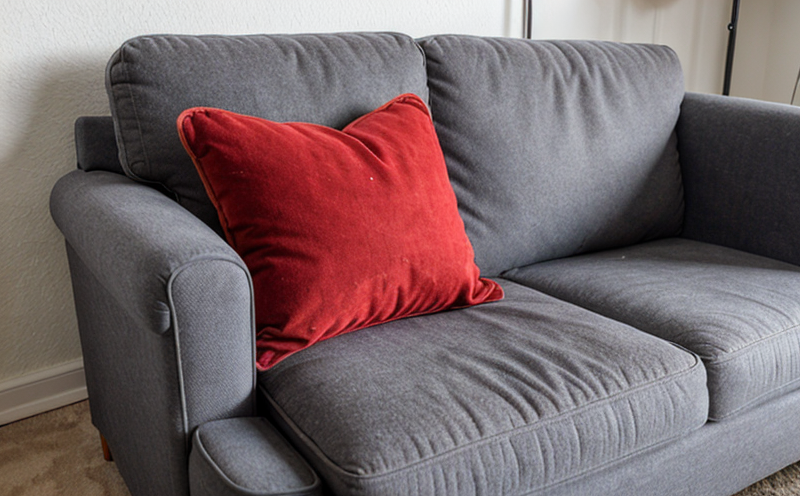ASTM D4157 Wyzenbeek Abrasion Resistance Testing of Upholstery Fabrics
The ASTM D4157 Wyzenbeek Abrasion Resistance Test is a critical method used to evaluate the durability and longevity of upholstery fabrics. This test simulates real-world wear and tear by subjecting fabric samples to repeated frictional abrasion, providing insights into how well the material will withstand frequent use in residential or commercial settings.
The Wyzenbeek machine, which is specifically designed for this test, rotates a sample of fabric back and forth between two plates. The number of cycles required to abrade through the fabric is recorded as its abrasion resistance value. This data helps manufacturers and designers select fabrics that are suitable for high-traffic areas such as seating furniture or hospitality interiors.
The Wyzenbeek test is particularly important in sectors like home furnishings, hospitality, and office furniture where durability is a key consideration. Compliance with this standard ensures that products meet industry expectations regarding performance under typical use conditions. By incorporating ASTM D4157 into their quality assurance processes, manufacturers can enhance customer satisfaction by delivering robust, long-lasting products.
The test procedure involves careful preparation of the samples according to specified dimensions and standards provided in ASTM D4157. After preparing the specimen, it is mounted on a rotating arm within the Wyzenbeek machine. The machine then applies controlled frictional forces that simulate actual use scenarios. Throughout the process, data such as cycles-to-failure and visual inspection results are recorded.
Acceptance criteria for this test are based on the number of cycles before the fabric starts to show signs of wear or damage. Typically, fabrics used in high-traffic areas should exhibit a minimum resistance value that meets specific industry standards. Compliance with these standards not only ensures product quality but also enhances brand reputation and consumer trust.
Understanding the nuances of ASTM D4157 is essential for those involved in upholstery manufacturing and design. It allows them to make informed decisions about material selection, process optimization, and final product performance. By leveraging this test method effectively, companies can ensure their products not only meet but exceed customer expectations, thereby fostering long-term relationships with satisfied clients.
Industry Applications
- Furniture manufacturing
- Hotel and hospitality design
- Office furniture production
- Home furnishings retail
- Luxury goods production
- Textile engineering R&D
- Consumer product testing laboratories
Customer Impact and Satisfaction
The implementation of ASTM D4157 Wyzenbeek Abrasion Resistance Testing significantly impacts customer satisfaction in various ways. Firstly, it enhances the durability of products, ensuring they last longer under normal use conditions. This longevity translates directly into reduced replacement costs for end-users, thereby increasing overall value.
Secondly, compliance with this standard builds trust between manufacturers and consumers by demonstrating a commitment to quality and reliability. Customers can be assured that the upholstery fabrics used in their furniture meet rigorous performance standards, which contributes positively to brand perception.
Thirdly, the test results provide valuable feedback for R&D teams, helping them refine future product offerings based on real-world data. This iterative process ensures continuous improvement in product design and functionality, further enhancing customer experience.
In summary, ASTM D4157 Wyzenbeek Abrasion Resistance Testing plays a crucial role in maintaining high standards of quality across multiple industries. Its application not only improves product performance but also strengthens relationships between manufacturers and their clients, ultimately leading to higher levels of customer satisfaction.
Environmental and Sustainability Contributions
The ASTM D4157 Wyzenbeek Abrasion Resistance Test contributes positively to environmental sustainability by promoting the use of durable materials that minimize waste. By ensuring that upholstery fabrics can withstand extensive wear without compromising on appearance or functionality, this test encourages responsible material selection.
Manufacturers who adopt ASTM D4157 as part of their quality control measures are more likely to choose eco-friendly options that are inherently designed for longevity. This approach reduces the need for frequent replacements and associated resource consumption, contributing to a more sustainable production cycle.
In addition, by focusing on durability and performance, companies can reduce overproduction and stockpiling, which can lead to unnecessary disposal of unsold items. Such practices align with broader sustainability goals set forth by organizations like ISO 14001, encouraging environmentally conscious business operations.
Moreover, the test results provide a benchmark against which sustainable practices can be measured and improved upon over time. As industries continue to evolve towards greener operations, ASTM D4157 serves as an important tool in this transition, supporting both economic growth and environmental stewardship.





